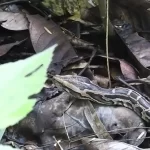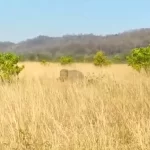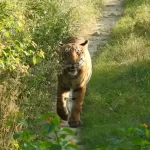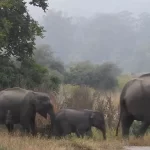1. This is the first documented record of the Smooth-Coated Otter occurring in Jhirna Tourism Zone of Corbett Tiger Reserve.
The smooth-coated otter (Lutrogale perspicillata) is found across South and South-east Asia. It occurs in suitable habitat across most of India and prefers freshwater lakes, rivers, ponds, wetlands etc, though it is also known to occur in saltwater along the coastal areas. It is a large otter weighing about 7-11 kg and growing upto 38-42 inches in length. Fish is the preferred diet of this species.
In Corbett Tiger Reserve, Smooth Indian Otter is found in River Ramganga and its tributaries. There are recent reports of its occurrence from River Kosi in Ramnagar Forest Division, along the eastern boundary of the reserve.
On 16th February 2019, while on a drive to Jhirna Tourism Zone of Corbett Tiger Reserve, Jim’s Jungle Retreat Naturalists Rakesh Bhatt and Pan Singh, who were accompanying Ms. Kirsty Norman and Mr. Paul Bolding, saw a Smooth Indian Otter in Jhirna Sot near Jhirna Forest Resthouse. A video of the otter that was catching fish in the shallow water of the stream was taken.
2. The Russell’s viper (Daboia russelii), is a highly venomous snake found across much of south Asia, south-east Asia, southern China and Taiwan. Characterized by a flattened, triangular head that is distinctly broader than the neck and a pattern of oval-shaped markings along its body, the Russell’s Viper grows to a maximum length of 5.5 ft with most specimens being about 4 ft in average length. It occurs in open grassy and bushy areas, arid rocky areas, scrublands and open dry forests.
In Corbett Tiger Reserve, the Russell’s Viper is an extremely scarce snake, found mostly along the southern boundary of the reserve. It is occasionally encountered in open areas scrubland areas around Tumaria reservoir.
This Russell’s Viper was recently seen basking on the road, on a birding excursion to Tumaria Reservoir. It was photographed by Jim’s Jungle Retreat Chief Naturalist Manoj Sharma who gently removed the serpent to a secure location among the boulders on the slope of the bund.
3. This pair of Sloth Bear was recently recorded by Jim’s Jungle Retreat Naturalist Rakesh Bhatt on a drive to Dhela Tourism Zone of Corbett Tiger Reserve.
The sloth bear (Melursus ursinus) is found across parts of Indian Subcontinent including India, Nepal and Sri Lanka. The species prefers grasslands, scrublands and tropical forests upto 1500 meters elevation. They have a shaggy coat and a lanky appearance, a mane around the neck and long sickle-shaped claws. Sloth Bear is omnivorous in its diet and feedson termites, fruits and plant matter and honeycomb. They are known to scavenge, many a times from Tiger kills.
In Corbett Tiger Reserve, there is a good presence of Sloth Bear, though they are quite shy and nocturnal due to the heavy presence of Tigers. Southern areas of the reserve including Jhirna and Dhela Tourism Zones are the strongholds of the species in the area.
4. This pair of Sloth Bear was recently recorded by Jim’s Jungle Retreat Naturalist Rakesh Bhatt on a drive to Dhela Tourism Zone of Corbett Tiger Reserve.
The sloth bear (Melursus ursinus) is found across parts of Indian Subcontinent including India, Nepal and Sri Lanka. The species prefers grasslands, scrublands and tropical forests upto 1500 meters elevation. They have a shaggy coat and a lanky appearance, a mane around the neck and long sickle-shaped claws. Sloth Bear is omnivorous in its diet and feedson termites, fruits and plant matter and honeycomb. They are known to scavenge, many a times from Tiger kills.
In Corbett Tiger Reserve, there is a good presence of Sloth Bear, though they are quite shy and nocturnal due to the heavy presence of Tigers. Southern areas of the reserve including Jhirna and Dhela Tourism Zones are the strongholds of the species in the area.
5. The Yellow-throated Marten (Martes flavigula) is the largest Marten occurring in the old world. Territorial in nature, it actively patrols its territory and may cover upto 20 km during the course of a single day & night. Known to hunt both on the ground and in the canopy of the trees, the Yellow-throated Matren’s diet includes rodents, birds, small reptiles and it regularly takes eggs and young ones from birds’ nests. It is often known to bring down prey which is larger than its own size and there are records of Rhesus Macaque, Grey Langur, Muntjac fawns, Musk Deer, Spotted Deer, Goral and Wild Boar piglets being hunted. It is also known to trail the Tigers and take opportunity to steal from their kills.
This Yellow-throated Marten was recorded in Dhela Zone of Corbett Tiger Reserve by Jim’s Jungle Retreat Chief Naturalist, Manoj Sharma, while it was scratching and grooming itself in a tree.
6. Indian Owlet-moth is a beautiful nocturnal moth belonging to ‘Eribidae’ family of moths. It has a large distribution range from Japan, Korea, Taiwan and China to India, Nepal, Bangladesh, Sri Lanka and into south-east Asia in Myanmar, Cambodia, Laos, Vietnam, Thailand, Malaysia, Indonesia and Philippines.
The species displays an interesting pattern on its wings that resembles a snake’s face with slightly open mouth. This is a defense strategy developed through the long course of evolution and helps the moth escape its predators.
This Indian Owlet-moth was photographed at Jim’s Jungle Retreat by our Chief Naturalist, Manoj Sharma.
7. Bengal Bushlark has a strong bill, short tail, white supercilium, strong dark streaks on grey upperparts, spotting on upper breast and behind the ear-coverts, warm colouration to underparts and rufous colouration to the wings. It is resident in the Indian subcontinent and south-east Asia, distributed in India, Nepal, Bhutan, Bangladesh and Myanmar. It prefers open areas including grasslands, dry and rocky patches, scrubland and cultivation.
It is a breeding resident in Corbett Tiger Reserve, alon the southern boundary of the reserve. This fine specimen was photographed recently by Jim’s Jungle Retreat Chief Naturalist Manoj Sharma in Laldhang grassland of Dhela Tourism Zone of Corbett Tiger Reserve.
8. The Yellow-throated Marten (Martes flavigula) preys upon rates, mice, hares, snakes, lizards and takes eggs and young ones of birds. It hunts birds, as big as pheasants and peafowl and attacks poultry. It is known to bring down larger prey including cats, small ungulates, Musk Deer, Spotted Deer & Goral. In Corbett Tiger Reserve, it has been recorded preying upon Rhesus Macaque and Tarai Grey Langur.
On a drive to Dhela Tourism Zone of Corbett Tiger Reserve, we came across this Yellow-throated Marten that attacked and caught a Five-striped Palm Squirrel. The Squirrel tried to escape the Marten by running around the trunk of a Sal tree and though the Marten is much bigger than the Squirrel, it managed to outmaneuver and catch it. The kill was taken to the fork of a large Banyan tree where it was eaten at peace. This video was taken by Jim’s Jungle Retreat guest ‘Vir Mehta’. April and May is a good season to look for this elusive mammal in areas around Dhela and Jhirna Tourism Zones of Corbett Tiger Reserve.
9. Elephants have large dark bodies and in the summer they have a great need for water to cool themselves. Usually the Elephant herds spend the hot hours of the day in the shade of the forest and during late afternoon, venture out into open grassland areas to visit waterholes or visit suitable sources of water in the river valleys. When undisturbed, they love to spend some time splashing, spraying and rolling around in water.
This herd of Elephants was recorded by Jim’s Jungle Retreat’s Chief Naturalist, Manoj Sharma at a waterhole in Laldhang grassland of Dhela Tourism Zone, Corbett Tiger Reserve.
It is common to come across such Elephant herds in Dhela and Jhirna Tourism Zones of Corbett Tiger Reserve, located close to Jim’s Jungle Retreat, during the summer months.
10. Tiger is the largest cat in the world. A male Bengal Tiger has an average length of 9 to 10 feet, including the tail and similarly, a female can be as big as 7.5 to 8.5 feet. The largest Tiger ever recorded in the foothills of Himalayas, in the present-day state of Uttarakhand, was ‘Bachelor of Pawalgarh’, shot in the winter of 1930 by Jim Corbett and measured at 10 feet 7 inches over the curves.
The average weights of Bengal Tigers can be 180 to 250 kg for the males and 100 to 160 kg for the females.
Summer is a very good time to look for the Tigers, as the visibility through the ground vegetation improves. As the summer advances, the water sources dry up. Tigers have a great need for water in the hot weather and are usually seen near the few remaining water sources like waterholes and river valleys.
This massive male Tiger was recently recorded by Jim’s Jungle Retreat Chief Naturalist, Manoj Sharma, in fading light of the late evening, on one of the drives to Corbett Tiger Reserve. It was seen sitting in a small waterhole in a dry riverbed.
As the weather turns hotter, May and June are the best months to look for Tigers in Corbett Tiger Reserve. Located close to Jim’s Jungle Retreat are Dhela and Jhirna Tourism Zones of the reserve, areas that offer some of the best Tiger-viewing opportunities.
11. Tigers have their origin in the colder regions across Himalayas. The species spread southwards from the Palearctic region and arrived in India about 12000 years ago, entering from the north-east India and spreading throughout the length and breadth of the country. It has yet not fully adapted to the hot and humid conditions of Indian summer and monsoon and Tiger is the only cat in the world that goes and sits in water, to cool itself.
While on a drive in Corbett Tiger Reserve, our Chief Naturalist Manoj Sharma came across a big male Tiger sitting in a small patch of water in a corner of a grassy stream. It was late evening and the Tiger wanted to rest in this convenient spot, before starting its evening stroll. Meanwhile, a herd of Elephants emerged from the tall grasses on the other side of the stream and crossed from about 30 meters distance of the spot where the Tiger was, without raising any objections to its presence. The Elephants knew that the Tiger was not interested in their babies and were peacefully feeding in a patch of grass. There were Peafowl, Sambar and Spotted Deer within visible reach of the Tiger but none of the forest denizens were alarmed. Everyone knew that a Tiger sitting in water is a threat to none. After some time, the Tiger got up and started walking along the side wall of the stream, behind the Elephants, and crossing the stream at a few meters distance from the Peafowl, who ignored its close proximity.
It seemed as if the water truce had been declared and there was peace in the jungle!
May and June are the best months of the year to look for the Tiger around the waterholes and forested streams of Dhela, Jhirna and Bijrani Tourism Zones of Corbett Tiger Reserve, located close to Jim’s Jungle Retreat
12. Cormorants are aquatic birds that specialize in catching fish by diving underwater. Little Cormorant is the smallest cormorant species found in the Indian subcontinent and is distributed across India, Sri Lanka, Pakistan, Nepal, Bangladesh and into South-East Asia. It is known to forage in small groups and are often seen foraging alone. However, when the species congregate in large numbers to indulge in some communal fishing, it is more of a massacre for the fish. Large number of birds dive from the water surface, pursuing the fish underwater. Those fish that come closer to the water surface can be caught by the birds that are on the surface. There is so much of movement and action caused by the birds, with a majority of birds frequently diving underwater and the remaining replacing them as these surface, that the fish are not left with any escape routes.
Terns are aquatic birds specialising on catching fish from the water’s surface by diving from air. Whiskered Tern is distributed across Europe, Africa, Asia and Australia. The species is quick to take advantage of opportunities presented by a group of cormorants that are hunting fish. The fish that come closer to the water’s surface in order to escape the underwater diving cormorants is caught by the Whiskered Tern that are hovering above.
This video was recently shot by Jim’s Jungle Retreat Chief Naturalist, Manoj Sharma at Tumaria Reservoir, located on the Southern side of Corbett Tiger Reserve, not too far from Jim’s Jungle Retreat. Summer is a good time to go birding at Tumaria Reservoir as the water shrinks and the birds can be seen in good numbers. There are several species breeding in the hot weather and many species are seen on the passage migration during this period.
13. Corbett Tiger Reserve has the largest population of tigers for any single reserve, with more than 200 counted during the last census. In summer, Tigers have a great need for water and move around in their territory in search of water sources. This is the time of the year when Tigers are frequently seen by the visitors in the various tourism zones, often crossing roads.
June is the best time of the year to look for Tigers in Dhela, Jhirna and Bijrani Tourism Zones of Corbett Tiger Reserve. This Tigress was recently recorded on a safari to Corbett Tiger Reserve by Jim’s Jungle Retreat Naturalist, Rakesh Bhatt.
14. Butterfly Season at Jim’s Jungle Retreat – Rounded Pierrot (Tarucus Nara) and Forget-Me-Not (Catochrysops Strabo) photographed on the property by our naturalists.
Lycaenidae is the largest family of butterflies with more than 6000 species found across the world. In India, there are more than 440 species of butterflies belonging to this family. Most of these species have blue upperparts and hence these are called ‘Blues’.
Rounded Pierrot is a tiny butterfly belonging to family Lycaenidae. It is an uncommon species to encounter in Corbett Tiger Reserve. It is a tiny butterfly with a wingspan is 23-28 mm and is endemic to India, Nepal, Sri Lanka, and Pakistan. It has a slow fluttery flight over low grasses and shrubs. Primarily a species of lowlands, it has been recorded up to 2130m in the Himalayas and is active throughout the year.
Forget-Me-Not is another butterfly belonging to family Lycaenidae. It is a small butterfly with a wingspan of 23-35 mm. An uncommon species in Corbett Tiger Reserve, it is distributed across India, Pakistan, Sri Lanka, Nepal, Bhutan and Bangladesh in the Indian subcontinent and extending through south-east Asia till Australia. It is a fast flying butterfly and prefers open dry scrub and deciduous forests.
Summer and monsoon are good times to look for the butterflies in the foothills of Himalayas and there are many species being seen these days at Jim’s Jungle Retreat, located on the southern boundary of Corbett Tiger Reserve. These uncommon butterflies of Corbett Tiger Reserve have recently been photographed at Jim’s Jungle Retreat by the members of our naturalist team, Balam Singh and Jeewan Routela.
15. Brahminy Starling is a resident breeding species in India and Nepal. It is usually seen during summer in Pakistan and migrates to Sri Lanka in winters. It can be seen in small flocks in open areas including cultivations, grasslands, dry forests, scrub jungle and near human habitations. The species gets it’s name from the saffron colours of it’s body feathers that resemble the colour of the clothes worn by the ‘Brahmin’. Moreover, it’s head feathers are black in colour and taper down the nape, like the ponytail of the ‘Brahmin’. It is an omnivorous species taking fruit and insects. The species nests in the tree holes and other artificial cavities.
Brahminy Starling is a resident breeding species of Corbett Tiger Reserve and monsoon is one of the best times to catch a glimpse of this beautiful bird. It is often seen at Jim’s Jungle Retreat during July and August, where it is seen feeding insects to its young ones. Laldhang grassland in Dhela Tourism Zone of Corbett Tiger Reserve is also a good place to see this species in good numbers during the monsoon.
16. Recently, on our arrival at the High Bank near the treehouse, we spotted a family of four Tigers sitting in a waterhole on the other side of the Kothirao stream. The mother was quietly sitting in the water, surrounded by her three cubs who were playful.
17. Moths, like butterflies, belong to order ‘Lepidoptera’. There are about 160000 species of Moths in the world and it is believed that many of these are still to be described scientifically.
Moths differ from butterflies in a few ways. As compared to Butterflies, which are mostly diurnal, most of the Moths are nocturnal or crepuscular. Butterflies have thin clubbed antennae whereas Moths may have various shapes to their antennae. Whereas most of the Butterflies rest with their wings closed, most of the Moths rest with their wings open.
Moths, however are believed to have evolved before the Butterflies with fossil records dating more than 190 million years old. Moths and Butterflies, apart from being a good food source for various organisms like birds, spiders, frogs, lizards etc, are major agents of pollination.
National Moth Week is a worldwide event to study and record the diversity of Moths. Founded in United States of America in 2012, this citizen-scientist event is celebrated during the last week of July every year, in over 80 countries worldwide.
Jim’s Jungle Retreat, located at the southern boundary of Corbett Tiger Reserve, has amazing Moth diversity. Monsoon is a great time to enjoy the beauty of these lovely creatures, as this is when they are present in phenomenal numbers.




